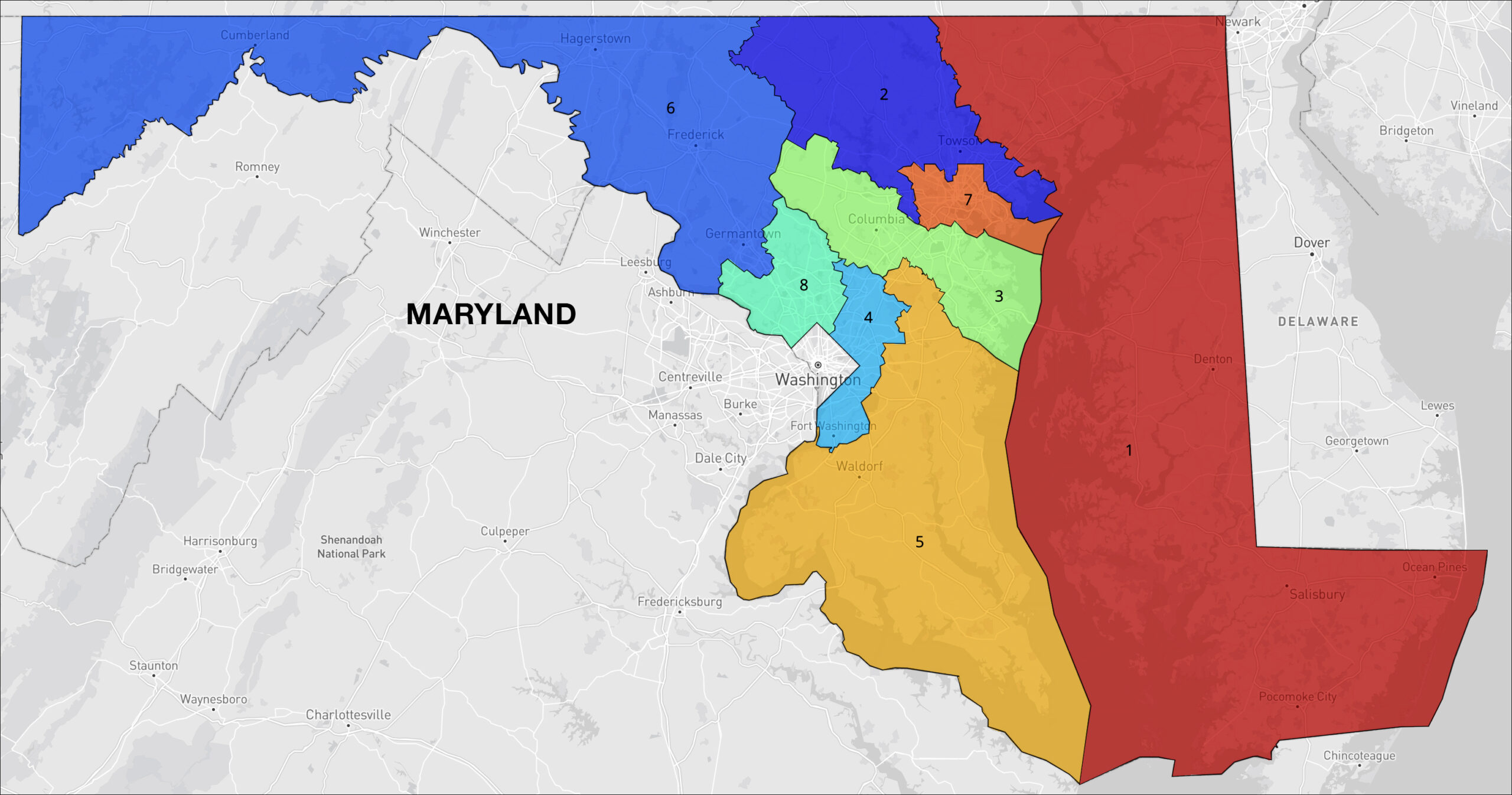
Maryland Congressional Districts (Click on map to see interactive version on DavesRedistricting.org.)
By Jim Ellis — Monday, Nov. 3, 2025
Redistricting
We saw redistricting moves occur in several states last week. Below is a recap of the action:
Louisiana
As the redistricting world awaits the US Supreme Court’s ruling on the Louisiana racial gerrymandering case, the Bayou State’s Governor and legislature passed legislation to move the state’s primary in anticipation of a ruling coming well after the first of next year.
Previously, the legislature and Gov. Jeff Landry (R) changed the Louisiana primary system to do away with their jungle primary held concurrently with the general election and an accompanying December runoff for those races where no candidate received majority support on the initial vote.
The new primary system returned to a partisan format scheduled for April 18, 2026, with a two-candidate runoff on May 30 for the races where no candidate received majority support.
The legislation passed earlier last week, now on its way to Gov. Landry for his signature, would move the initial primary date to May 16 with the associated runoff election on June 27.
Changing the primary will give the state more time to adjust their congressional map to adhere to whatever the Supreme Court eventually decides. The change also gives the candidates more time to campaign in the Senate primary where several contenders are mounting GOP nomination challenges against Sen. Bill Cassidy.
Maryland
It appears the Maryland legislature will not engage in another redistricting. According to a report from The Down Ballot political blog, state Senate President Bill Ferguson (D-Baltimore) sent a letter to his colleagues saying that the Senate leadership “is choosing not to move forward with mid-cycle congressional redistricting.”
Sen. Ferguson’s argument is that redrawing the current map “… could reopen the ability for someone to challenge” the present plan upon which the Democrats were able to routinely claim seven of the state’s eight congressional seats. Basically, the Senate President was explaining he was not going to risk a 7D-1R map for an uncertain attempt to add one more to the Democratic column.
Without the Senate’s participation, redistricting in Maryland will not occur. Thus, we see a break for the state’s lone Republican Congressman, Andy Harris (R-Cambridge), and the national Republican goal of maximizing their number of seats through mid-decade redistricting.
Ohio
The Buckeye State has both a complicated redistricting system and law. The process first starts with a commission of elected officials who authorize the drawing of maps, then votes upon and presents the approved plan to each house of the legislature. A map must receive three-fifths support in both houses to remain in place for the entire decade. Passing with a lesser amount means the plan can stand for only two elections. The Governor retains veto power over the completed legislative process.
Since the 2021 congressional plan failed to receive three-fifths support in both the state House of Representatives and Senate, it could only remain in place for the 2022 and 2024 elections. Therefore, Ohio must enact a new congressional plan before the 2026 election.
The bipartisan commission came to an agreement on a map last week, which will now be reported to the legislature. Understanding that the Republicans have strong majorities in both houses, but not three-fifths strength, the plan appears to give the GOP a chance to increase their delegation share by two seats.
The partisan percentage increase in both principal targets, however, appears to still make Democratic victories possible. The purpose of the compromise is to obtain enough bipartisan support to keep a new map intact for the decade’s remaining elections.
Statistics for the districts are not yet publicly available, but the new plan appears to make Districts 7, 9, and 13 slightly more Republican.
District 7 is already a Republican seat that two-term Congressman Max Miller (R-Rocky River) represents. The 9th is veteran Democratic Congresswoman Marcy Kaptur’s Toledo-anchored seat where her victory margin under the current boundaries fell to less than a percentage point in 2024. Finally, the politically marginal Akron anchored 13th CD is also made a bit redder. Rep. Emilia Sykes (D-Akron) has averaged just under 52 percent in two consecutive elections.
Both Reps. Kaptur and Sykes were going to be major 2026 Republican targets and this map will make them only slightly more vulnerable.
Republicans were also looking to target 1st District Congressman Greg Landsman (D-Cincinnati), but this map keeps the district in the marginal category and likely makes the Congressman at least a slight favorite for re-election.
Much more will be known when the map statistics and voting history under the new boundaries become publicly available. Until then, the swing margins remain points of conjecture.
